Atlassian Bundle
Can Atlassian's Growth Strategy Continue to Dominate the Collaboration Software Market?
Founded in 2002, Atlassian has revolutionized team collaboration, evolving from a project management tool to a global software powerhouse. With over 300,000 customers and a suite of essential products, Atlassian's journey offers valuable insights into building a successful tech company. Understanding Atlassian's Atlassian SWOT Analysis is crucial for grasping its position in the market.
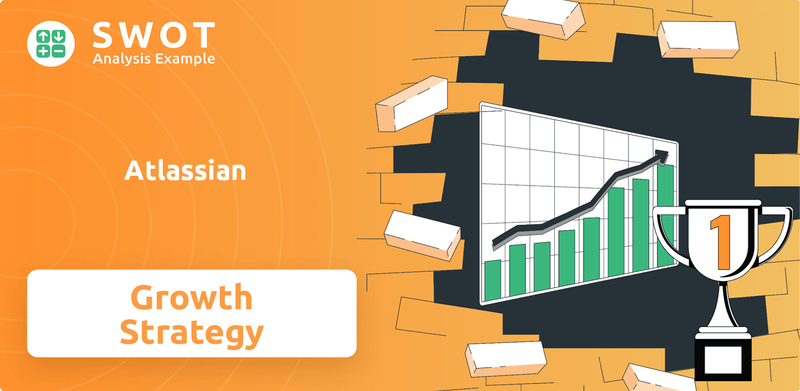
This exploration dives into Atlassian's dynamic growth strategy, examining its innovative approach to product development, including its cloud-first strategy and the integration of AI. We'll analyze Atlassian's future prospects, considering its expansion plans and the competitive landscape, to provide a comprehensive Atlassian market analysis. Furthermore, we'll explore how Atlassian's business model and customer acquisition strategies are shaping its long-term goals and influencing Atlassian's stock performance outlook within the SaaS industry.
How Is Atlassian Expanding Its Reach?
The expansion initiatives of the company are primarily driven by a cloud-first strategy, focusing on broadening its market reach beyond its traditional IT customer base. This approach involves significant investment in cloud offerings to enhance scalability, security, and ease of use, alongside support for a smooth transition for existing customers. The company's strategic moves also include expanding its tools to departments beyond IT, such as HR and Marketing, through its 'System of Work' framework, aiming to become the enterprise system for all collaboration workflows.
A key aspect of this growth strategy is the migration to the cloud. The company officially ended server support in February 2024, pushing customers towards cloud migration or Data Center solutions, with many apps now being cloud-first. As of February 2025, a significant portion of organizations have already migrated, while a considerable number are still in the process. This transition is crucial for the company's future prospects, as it allows for more efficient service delivery and the integration of new features.
The company's commitment to innovation and development is evident in its product launches and enhancements. For instance, the general availability launch of Rovo, its AI-powered solution, occurred just five months after its announcement. Jira Product Discovery, launched in Q4 FY23, is experiencing substantial growth, with over 14,000 customers and a new Premium edition recently added. These developments, along with continued investment in the marketplace, which boasts over 5,700 apps, are pivotal to the company's expansion plans.
As of February 2025, 52% of organizations needing to migrate have completed the process. 42% are still in progress, highlighting the ongoing effort to transition customers to the cloud.
Jira Product Discovery is growing over 150% year-over-year. This rapid growth underscores the effectiveness of the company's product roadmap and its ability to meet evolving customer needs.
The company's marketplace features over 5,700 apps. This extensive ecosystem enhances the functionality of its core products and provides customers with a wide range of solutions.
The company has landed a record number of deals with over $1 million in annual contract value. This success highlights the effectiveness of its strategy to expand beyond traditional IT customers.
The company's expansion is fueled by its cloud-first strategy and the broadening of its market reach. This involves a focus on cloud migration, product innovation, and strategic partnerships to enhance its market position. To understand the competitive landscape, consider the Competitors Landscape of Atlassian.
- Cloud-First Strategy: Prioritizing cloud solutions for scalability and ease of use.
- Product Innovation: Launching new products like Rovo and enhancing existing ones.
- Marketplace Growth: Expanding the ecosystem of apps to extend product functionality.
- Enterprise Focus: Targeting departments beyond IT to broaden its customer base.
Atlassian SWOT Analysis
- Complete SWOT Breakdown
- Fully Customizable
- Editable in Excel & Word
- Professional Formatting
- Investor-Ready Format
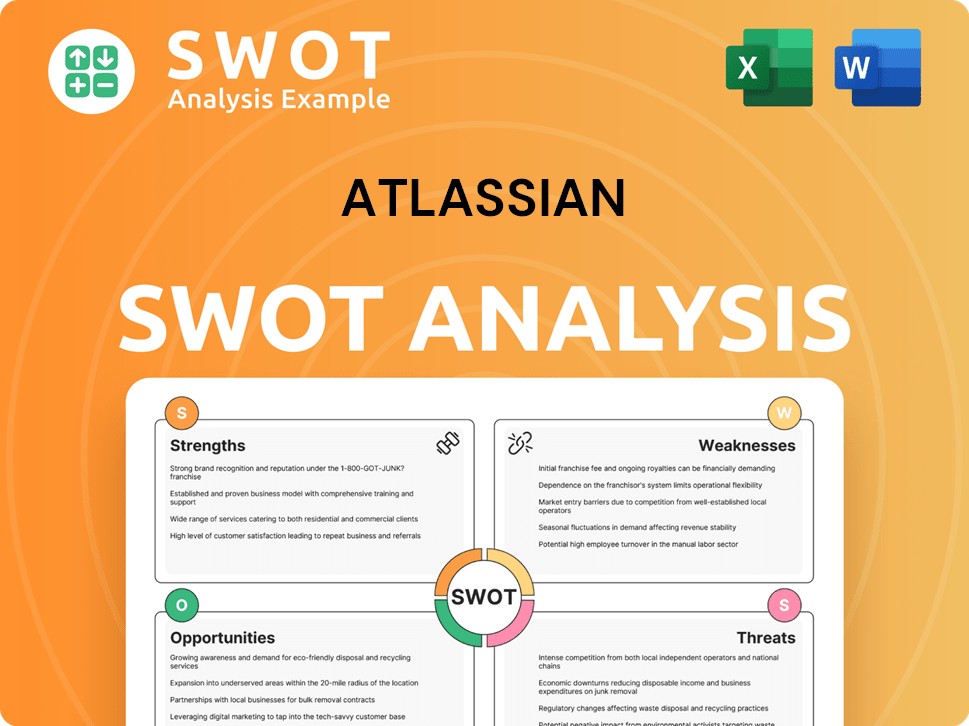
How Does Atlassian Invest in Innovation?
The innovation and technology strategy of the company is a key driver of its growth. This strategy focuses heavily on artificial intelligence (AI) and cloud solutions to enhance workflows and boost productivity. The company's approach aims to make advanced technologies accessible and user-friendly across various teams, including marketing, HR, and finance.
A core element of the company's strategy is its investment in research and development (R&D). This commitment supports the delivery of new products and updates, such as AI-powered support for its services. The company's cloud platform and 'Teamwork Graph' further enable teams to leverage organizational knowledge across applications.
The company's emphasis on AI includes the development of solutions like Rovo, designed to streamline processes through customizable automation. The company anticipates that 2025 will be the 'year of the AI agent,' with agents becoming more sophisticated and integrated across products.
The company is 'doubling down on AI' to optimize workflows and enhance productivity across its suite of tools. This includes integrating AI into products to streamline processes and improve user experience.
The introduction of Rovo, an AI-powered solution, is designed to streamline processes with customizable automation. Rovo aims to simplify complex tasks and improve efficiency for users.
The company focuses on democratizing AI within organizations, making AI capabilities accessible to all teams. This approach ensures that teams like marketing, HR, and finance can utilize AI without needing specialized data science expertise.
The company anticipates that 2025 will be the 'year of the AI agent,' with agents becoming more sophisticated. These agents will handle complex tasks and integrate across various products, enhancing their functionality.
Research and development expenses for the twelve months ending March 31, 2025, were $2.558 billion, a 23.57% increase year-over-year. For the quarter ending March 31, 2025, R&D expenses were $0.685 billion, an 18.88% increase year-over-year.
The company's cloud platform and 'Teamwork Graph' enable teams to unlock organizational knowledge across applications. This feature enhances collaboration and knowledge sharing within organizations.
The company's significant investment in R&D underscores its commitment to delivering new products and updates. For example, advancements in AI-powered support for Jira Service Management have resulted in a 30% deflection rate for requests in a composite organization. The company was also recognized as an Emerging Leader in Gartner's 2025 Innovation Guide for Generative AI Technologies, highlighting its role in shaping the future of AI-powered teamwork. For a deeper dive into the company's strategic moves, you can explore the latest insights on the company's growth strategy.
The company focuses on AI, cloud solutions, and substantial R&D investments to drive its growth. These strategies are designed to enhance productivity, streamline processes, and improve user experience.
- AI Integration: Integrating AI across tools to optimize workflows.
- Rovo Launch: Launching AI-powered solutions for process automation.
- R&D Investment: Significant investment in research and development.
- Cloud Platform: Leveraging the cloud platform for enhanced collaboration.
- AI Agent Development: Anticipating the rise of sophisticated AI agents.
Atlassian PESTLE Analysis
- Covers All 6 PESTLE Categories
- No Research Needed – Save Hours of Work
- Built by Experts, Trusted by Consultants
- Instant Download, Ready to Use
- 100% Editable, Fully Customizable
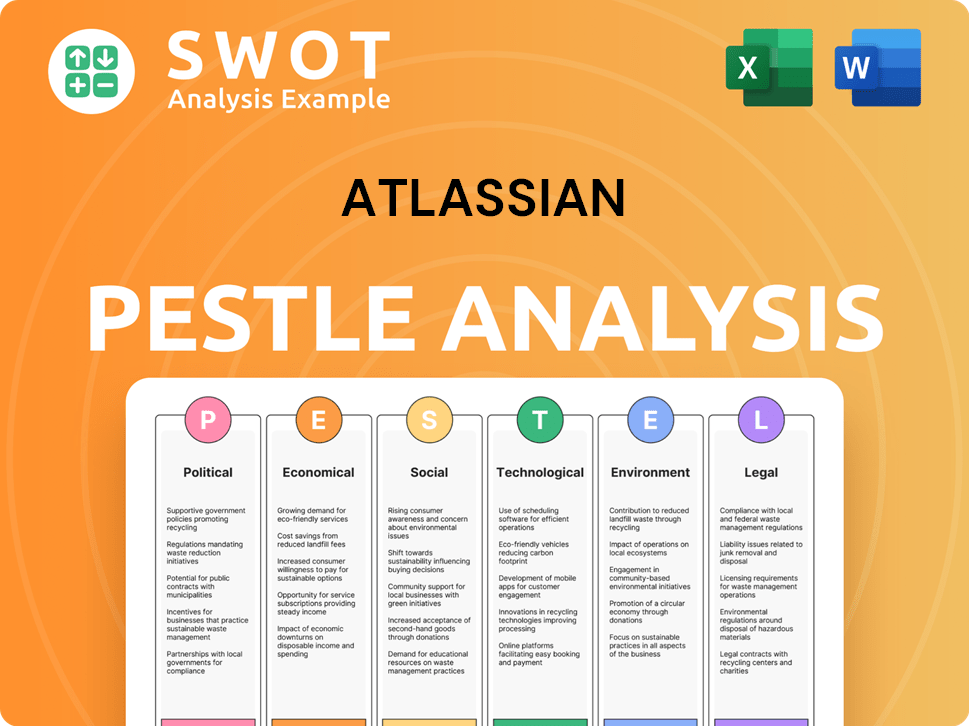
What Is Atlassian’s Growth Forecast?
The financial outlook for Atlassian indicates continued expansion, with a strong emphasis on cloud revenue. The company's strategic focus on cloud services is evident in its financial projections and operational decisions. This focus is expected to drive overall revenue growth and shape the company's financial performance in the coming years.
For the third quarter of fiscal year 2025, Atlassian reported total revenue of $1,356.7 million, reflecting a 14% increase compared to the same period in fiscal year 2024. This growth was primarily fueled by a 25% year-over-year increase in Cloud revenue. The company's financial performance is closely tied to its ability to grow its cloud offerings and attract new customers to its platform.
The company's financial strategy is supported by a solid financial foundation, with cash and cash equivalents plus marketable securities totaling $3.0 billion at the end of the third quarter of fiscal year 2025. This strong financial position provides Atlassian with the flexibility to invest in future growth opportunities, including product development, market expansion, and potential acquisitions. For more details, check out the Revenue Streams & Business Model of Atlassian.
For the fourth quarter of fiscal year 2025, Atlassian anticipates total revenue to be in the range of $1,349 million to $1,359 million. This projection reflects the company's expectations for continued growth across its product lines. The company's ability to meet or exceed these revenue targets will be a key indicator of its financial health and market position.
Cloud revenue growth year-over-year is expected to be approximately 23.0% for fiscal year 2025. This significant growth in cloud revenue highlights the company's strategic shift towards cloud-based services. This growth is expected to be a major driver of overall revenue and profitability.
Data Center revenue growth is anticipated at approximately 20.0% for fiscal year 2025. Marketplace and other revenue growth is expected to be approximately 5.0% for fiscal year 2025. These figures show the company's strategy to diversify its revenue streams and maintain a strong market presence.
For the full fiscal year 2025, the company expects a GAAP operating margin of approximately (6.0%) and a non-GAAP operating margin of approximately 21.5%. The non-GAAP margin provides a clearer view of the company's profitability by excluding certain expenses. These margins reflect the company's ability to manage costs and generate profits.
Analysts project Atlassian's fiscal year 2025 revenues to be approximately $5.08 billion, indicating a year-over-year growth of 16.64%, and earnings per share (EPS) to grow by 8.5%. The average analyst price target for Atlassian stock for the next 12 months is $267.70, with a high forecast of $325.00 and a low forecast of $215.00. These projections reflect the positive outlook for the company's future performance.
- Atlassian growth strategy focuses on cloud services.
- Atlassian future prospects include continued revenue growth and profitability.
- Atlassian market analysis shows strong cloud revenue growth.
- Atlassian business model is supported by a solid financial foundation.
Atlassian Business Model Canvas
- Complete 9-Block Business Model Canvas
- Effortlessly Communicate Your Business Strategy
- Investor-Ready BMC Format
- 100% Editable and Customizable
- Clear and Structured Layout
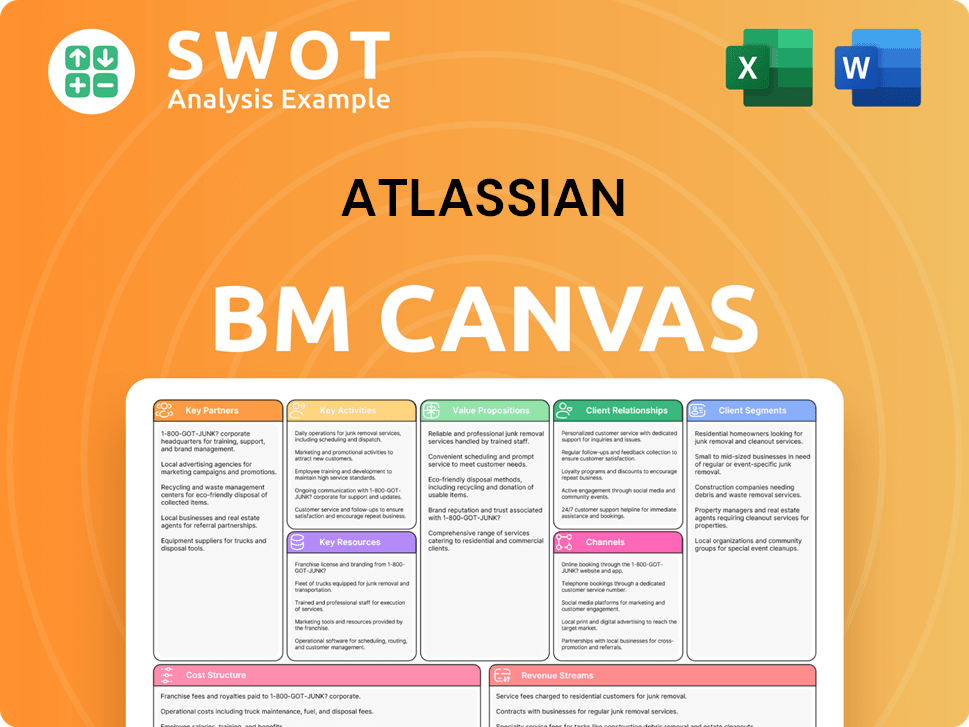
What Risks Could Slow Atlassian’s Growth?
The Atlassian company faces several potential risks and obstacles that could impact its growth trajectory. These challenges span strategic, operational, and market-related areas. Understanding these hurdles is crucial for evaluating the company's future prospects and making informed decisions.
A key area of concern is the ongoing migration from Server to Cloud. The transition, which officially ended Server support in February 2024, presents a significant challenge for the company. While the company is working to maintain its position in the market, it is important to acknowledge the risks involved.
Market competition and the need for continuous innovation are also significant factors. Rapid technological advancements, particularly in areas like AI, demand substantial R&D investments. Economic downturns and data security concerns also pose risks. This article provides an overview of the challenges Atlassian must navigate to sustain its growth.
The transition from Server to Cloud is a major undertaking for Atlassian. As of February 2024, Server support officially ended, requiring customers to migrate. Data security and potential breaches are risks for those still using server products.
The software market is highly competitive, with established tech giants and specialized startups vying for market share. This competitive landscape necessitates continuous innovation and effective strategies to retain and attract customers.
Data security, privacy, and data localization are critical concerns, especially for enterprises transitioning to the cloud. The company must address high-severity vulnerabilities in its products to prevent attacks.
Rapid technological changes require significant R&D investment. In Q1 FY2025, non-GAAP R&D expenses increased by 23.7% year-over-year, outpacing revenue growth of 21.5%. This can impact profitability.
The company's customer growth rate is decelerating. Its CAGR was 14.7% between fiscal 2020 and 2024, compared to 30% between fiscal 2016 and 2020. This presents a near-term challenge.
Economic downturns impacting IT budgets could pose a threat. Reduced spending by customers could negatively affect the company's revenue and growth. This is one of the factors that need to be considered.
Atlassian is actively addressing these risks through various strategies. These include ongoing security updates, a focus on compliant cloud solutions, and strategic investments in areas like enterprise and AI. The company is working towards FedRAMP compliance by 2025.
The company's cloud strategy is central to its future prospects. The company is providing tools and support to facilitate the Server to Cloud migration. This includes resources and assistance to help customers transition smoothly.
Continuous innovation is crucial in the competitive software market. The company is investing heavily in R&D to stay ahead of technological changes. This includes exploring new technologies and enhancing existing products.
Strategic investments and potential partnerships may be necessary to fuel growth and address market challenges. These investments could focus on areas like AI and enterprise solutions. For more details on the target market, see Target Market of Atlassian.
Atlassian Porter's Five Forces Analysis
- Covers All 5 Competitive Forces in Detail
- Structured for Consultants, Students, and Founders
- 100% Editable in Microsoft Word & Excel
- Instant Digital Download – Use Immediately
- Compatible with Mac & PC – Fully Unlocked
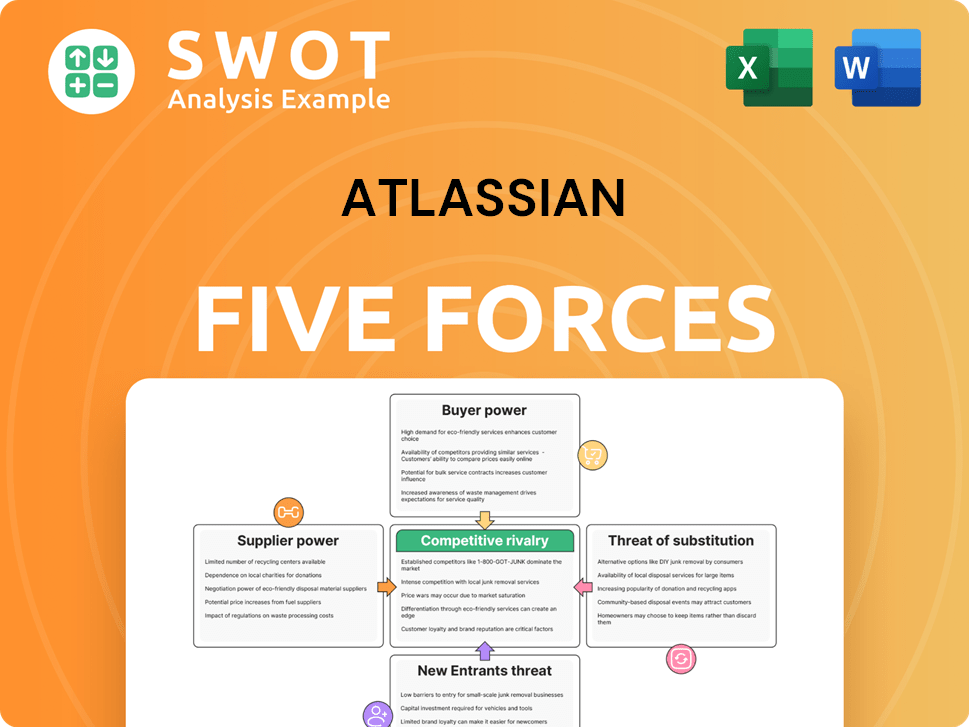
Related Blogs
- What are Mission Vision & Core Values of Atlassian Company?
- What is Competitive Landscape of Atlassian Company?
- How Does Atlassian Company Work?
- What is Sales and Marketing Strategy of Atlassian Company?
- What is Brief History of Atlassian Company?
- Who Owns Atlassian Company?
- What is Customer Demographics and Target Market of Atlassian Company?
Disclaimer
All information, articles, and product details provided on this website are for general informational and educational purposes only. We do not claim any ownership over, nor do we intend to infringe upon, any trademarks, copyrights, logos, brand names, or other intellectual property mentioned or depicted on this site. Such intellectual property remains the property of its respective owners, and any references here are made solely for identification or informational purposes, without implying any affiliation, endorsement, or partnership.
We make no representations or warranties, express or implied, regarding the accuracy, completeness, or suitability of any content or products presented. Nothing on this website should be construed as legal, tax, investment, financial, medical, or other professional advice. In addition, no part of this site—including articles or product references—constitutes a solicitation, recommendation, endorsement, advertisement, or offer to buy or sell any securities, franchises, or other financial instruments, particularly in jurisdictions where such activity would be unlawful.
All content is of a general nature and may not address the specific circumstances of any individual or entity. It is not a substitute for professional advice or services. Any actions you take based on the information provided here are strictly at your own risk. You accept full responsibility for any decisions or outcomes arising from your use of this website and agree to release us from any liability in connection with your use of, or reliance upon, the content or products found herein.